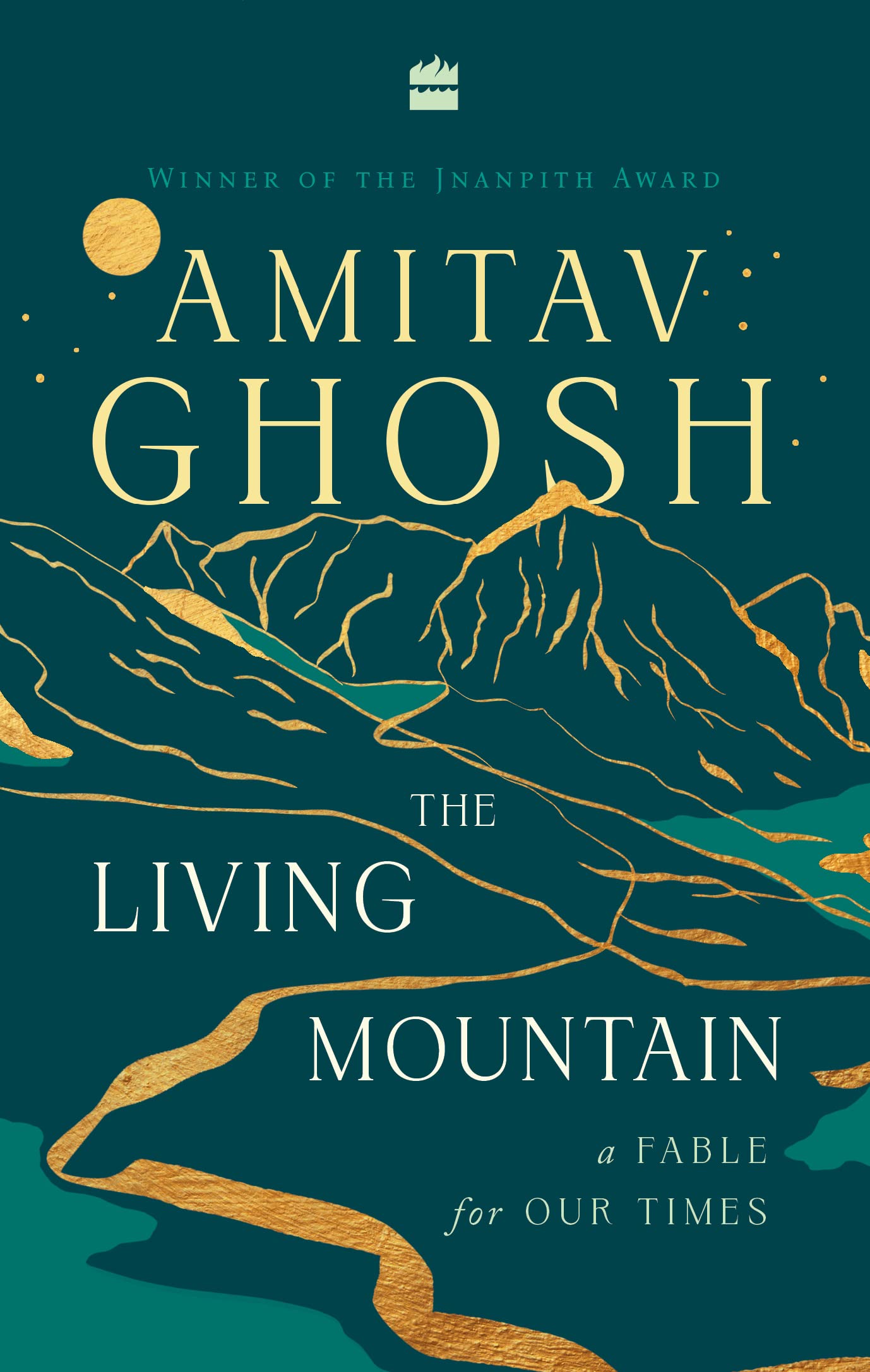Published September 21st, 2022
Review
by Damisha Salim
A story within a story, part dream, part memory of a grandma tale from childhood, The Living Mountain: A Fable for Our Times (2022) is a new, short work of fiction by Amitav Ghosh. It is a story of greed, invasion, and plundering. A narrative of fallacious beliefs and delusive hopes. A tale of forgetting “the old stories and songs and dances” in the face of the spectacle that is progress, relentless progress.
The story opens with an unnamed narrator introducing the reader to their online book club buddy, Maansi, who is also the first-person narrator of the tale of the Living Mountain. While surfing the web to set up the annual reading list for her book club around the theme of the Anthropocene, a term she was unfamiliar with, she comes across an unsettling book.
“I found a reading list online and picked out a book at random, thinking it would be nice and sciencey, with lots of numbers and charts. But it was nothing of the sort […].”
This particular detail in the story clearly underlines Ghosh’s contention with the purely techno-economic-scientific framing of the unfolding planetary crises. Echoing his emphasis on the role and need for stories in the highly uncertain times that we are living through, the book that Maansi picks is instead about a remote island and its people who suffered a terrible fate. Could that book be The Nutmeg’s Curse? Well, we can’t be sure. But it is our passage into the tale of the living mountain, the Mahaparbat.
The “snowy mountain, whose peak was almost always wreathed in clouds” overlooked a valley high up in the Himalayas. Maansi here is a young girl growing up in one of the warring villages of the Valley. People of all the villages, despite their differences, deeply revered the Mountain, for their ancestors had told them that the great, benevolent mountain would take care of them. They “told stories about it, and sang about it, and danced for it” and lived contented under the mountain’s protection and enjoyed its bounties. But all from a distance, for they were never to set foot on its slopes. This was one of the “binding laws” of the Valley.

The Mahaparbat nurtured the Magic Tree, which only grew in that valley, and bore its people rare mushrooms, scented honey, delicious fruit, and the miraculous fragrant nut within. The Valley people didn’t mind trading their nuts and all the other wares they produced. One year a stranger, an envoy of the Anthropoi, people from a land far away, arrives near the Valley. His people had heard about the Valley’s nuts and he was on a mission to explore the Valley and learn about it. Here, for anyone who has read The Nutmeg’s Curse, the allusion to the nutmeg that attracted the Portuguese to the Banda Islands, eventually leading up to horrific episodes of invasion, destruction, genocide, and looting becomes quite evident. The distressing anticipation about how the tale will unfold is hard to evade.
The envoy, like all the other strangers, traders, and explorers, isn’t allowed into the Valley. But he manages to learn whatever he can about the Valley, the “trade goods” it produces, and the mighty Mahaparbat from the Elderpeople of the Valley and then he leaves. A few years later more strangers arrive, a horde of them this time. They were not here for the nuts; they were here for the Valley itself. The Anthropoi, armed with destructive weapons, had come to climb and conquer the Mahaparbat. The Valley people decide to fight, put up a resistance, but are defeated on all fronts.
The Anthropoi do not only conquer the Valley and the Mountain, but also manage to subjugate over time the conscience, values, and beliefs of the people therein: their beliefs about the Mountain, their Valley, and themselves.
The story sounds uncannily familiar and relevant? That’s exactly what it is meant to be: a fable for our times.
“[…] the spectacle [of the climb] took the place that the Mountain had once occupied in our hearts […].”
One of the most pivotal symbols in the tale is ‘the climb’. It aptly represents the modern ideal of relentless progress, and what our understanding of being advanced and ahead has become. Undoubtedly, essential to this ‘never-ending progress’ narrative is colonial conquest – of both the landscape and its people across the world. And Ghosh, by employing conspicuous symbols and metaphors, has managed to evoke vivid images of different modes and continuities of colonial exploitation within the short span of a few thousand words.
The Anthropoi’s obsession with climbing the slopes of the Mahaparbat reflects the capitalist and imperialist rendering of Earth as a mute and brute resource to conquer and exploit, exhausting the planet and everything in it of meaning, voice, and life. Subjugating the “benighted,” intellectually ignorant, and superstitious Valley people who believed a mountain to be alive into their servitude, the Anthropoi mirror the colonial suppression of non-mechanistic and vitalist thought processes across cultures and the savage-ization of people who adhered to them.
“But, to our dismay, we found that we had forgotten the old stories and songs and dances. We too had come to believe that they were foolish and fantastical and had no place in the Age of the Anthropoi.”
That the Valley people eventually internalize the high-handed narrative of the Anthropoi about themselves and the sacred Mountain and soon join the race to conquer the Mahaparbat is a befitting portrayal of the chequered and endless growth story of the third world/developing nations (as they have been named) in the so-called post-colonial era. All these nations wanted to catch up and continue to stress the need to have their fair share in the development, in the unquestioning pursuit of capital, investments, and progress, unaware of the costs of entering the race, just like the Valley people. They were blinded by the “exciting” lives of their conquerors and burned with “the desire to ascend those slopes” themselves. Until the Mountain decides to make its voice heard once again and shrugs off the label of passivity imposed on it. How? Read the book to find out.

The Living Mountain will primarily be classified as fiction, or perhaps eco-fiction, given our tendency to label and segregate things into proper, neat categories. But that doesn’t make it any less real and authentic than, let’s say, the story of the Banda Islands, the history of extractive colonial rule in South Asia, or the Opium Wars in China. What matters is that it is a story worth telling, a story that is needed. And that is exactly what makes it a great story.
Our current ecological predicament undoubtedly is at the heart of this tale, but the author doesn’t cater to it in an exclusive fashion. Here I recall Margaret Attwood’s remark that “it’s not climate change — it’s everything change.” Therefore, the stories we need are such that present an integrated narrative of various processes that have contributed to the current planetary situation. And Ghosh does precisely that. From our strained relationship with non-human forms of life on the planet to the marginalization of women, their experiences, and their outlook. From the colonial repression of indigenous knowledge, attitudes, and ways of life to the late-twentieth-century Great Acceleration. From the story of the opium trade to the history and origins of climate change, he has managed to weave all these different strands in the form of a wonder tale. The Living Mountain, thus, is an allegory of the making of our modern world, plagued by a myriad of social, economic, ecological, political, and philosophical dilemmas.
“[…] it was not the manner of the climb that was to blame for our troubles — it was the climb itself.”
The manner in which the author concludes this tale is definitely not a hopeful one. It does not entail an optimistic message, nor does it offer solutions that ought to work. But do all stories need to follow this narrative arc?
Rather, the tale ends with questions:
“How dare you speak of the Mountain as though you were its masters, and it were your plaything, your child? Have you understood nothing of what it has been trying to teach you?”
These simple questions represent our utter derangement, as Ghosh would like to call it, in the face of the planetary-scale calamities that are unfolding before our very eyes.
Call it destiny or mere coincidence, my reading of Ghosh’s works commenced amidst a global pandemic. A virus, invisible to the naked human eye, took over the world by storm, eventually becoming the most proximate, inescapable, and threatening non-human presence on the planet. A microscopic entity turned on its head our modern worldview of the past, present, and future that we thought was and is ours alone to mold. While we are still figuring out appropriate ways to conceptualize the existence and agency of non-human forms of life on earth, the various planetary environmental changes are hinting towards the way we should not be looking at them: as mute, brute, and passive. The human-non-human entanglements that are becoming increasingly obvious are hinting toward a more-than-human future. But are we taking the hints? Are we even trying to understand what they have been trying to communicate?
Such are the questions that The Living Mountain leaves its readers with. And we can hope that careful, sincere pondering may influence a positive change in our attitudes and inspire us to mend our ways.
Nationality: Pakistani
First Language(s): Urdu
Second Language(s):
English,
Persian,
Punjabi
Supported by:


Comments on "“We burned with the desire to ascend those slopes ourselves” — A Review of Amitav Ghosh’s "The Living Mountain""
Please log in to submit a comment.
Login